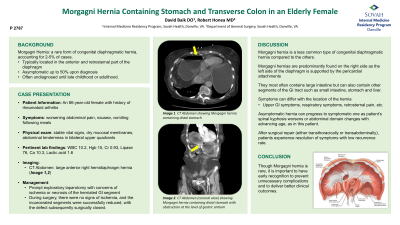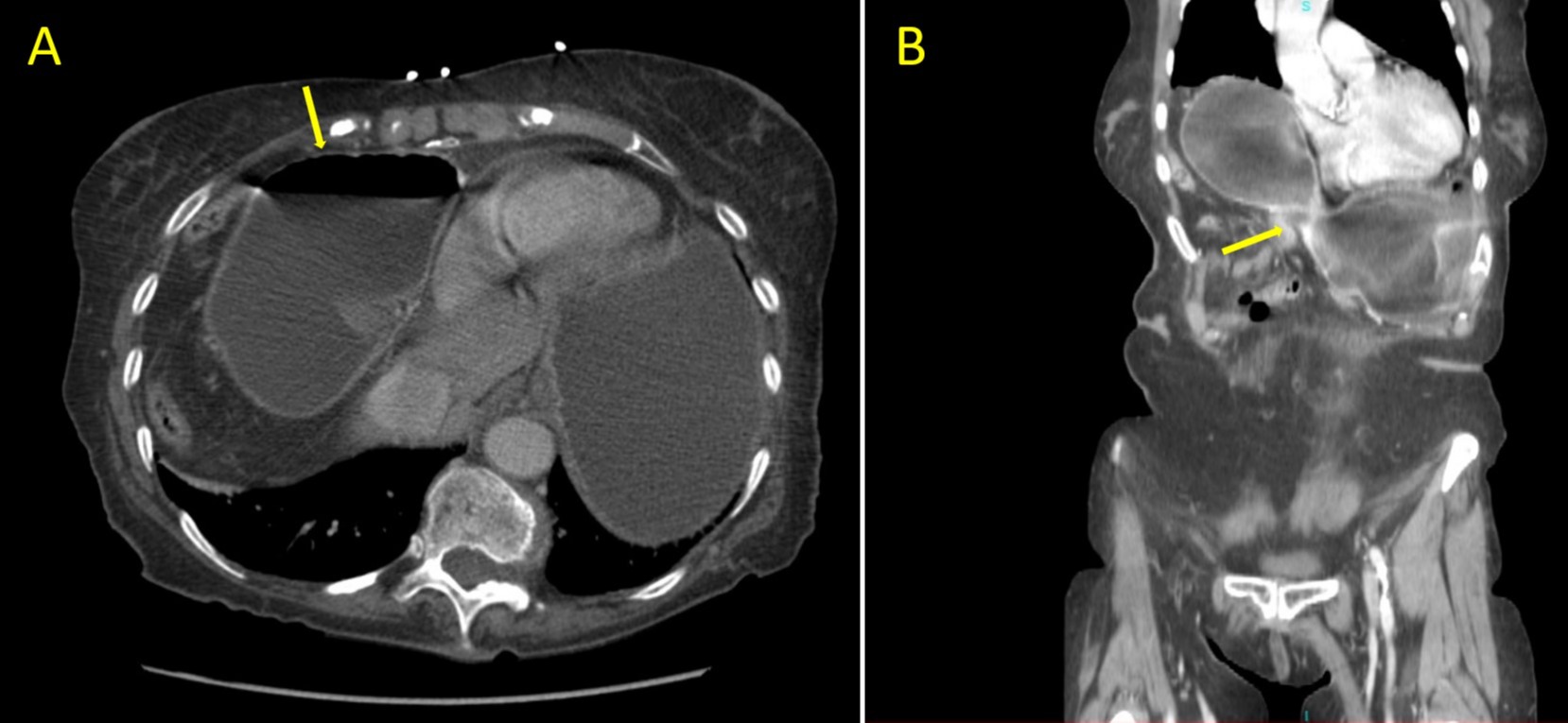Monday Poster Session
Category: Stomach
P2787 - Morgagni Hernia Containing Stomach and Transverse Colon in an Elderly Female
Monday, October 23, 2023
10:30 AM - 4:15 PM PT
Location: Exhibit Hall

Has Audio

David Baik, DO
SOVAH Health
Danville, VA
Presenting Author(s)
David Baik, DO1, Robert Honea, MD2
1SOVAH Health, Danville, VA; 2SOVAH, Danville, VA
Introduction: Morgagni Hernia is a rare form of congenital diaphragmatic hernia, accounting for 2% to 5% of cases. Typically located in the anterior and retrosternal part of the diaphragm, it is often asymptomatic up to 50% upon diagnosis and may go undiagnosed until late childhood or adulthood. This case presents an elderly female with a Morgagni hernia which was diagnosed in her late adulthood.
Case Description/Methods: An 86-year-old female with a history of rheumatoid arthritis and hyperlipidemia presented with a three-day history of worsening abdominal pain, nausea, and vomiting following meals. Unable to tolerate food, she experienced dehydration. Although previously diagnosed with Morgagni hernia, she had not experienced similar pain before. Despite a recent referral for a CT abdomen by a gastroenterologist, the patient sought emergency care due to escalating pain. In the ER, NG tube placement was attempted, which was unsuccessful. Physical examination revealed dry mucosal membranes, tenderness in bilateral upper quadrants, and stable vital signs. Laboratory findings were unremarkable: WBC 10.2, Hgb 15, Cr 0.93, lipase 76, Ca 10.3, and lactic acid 1.6. CT abdomen revealed a large anterior right hemidiaphragm hernia containing the distal stomach and colon with obstruction at the level of the gastric antrum. Concerns of ischemia or necrosis prompted surgical consultation. Exploratory laparotomy confirmed an incarcerated transverse colon and distal stomach within the Morgagni hernia, without signs of ischemia. The incarcerated segments were successfully reduced, and the defect was surgically closed. Histopathological examination revealed benign tissue.
Discussion: Morgagni hernias are predominantly found on the right side, as the left side of the diaphragm is supported by the pericardial attachments. The location of the hernia can lead to upper gastrointestinal and respiratory symptoms, as well as retrosternal pain. People with the hernia are more likely to present symptomatically as their kyphosis worsens and abdominal domain changes. Even asymptomatic cases warrant referral for surgical correction, as complications such as bowel obstruction, strangulation, volvulus, and necrosis can occur in up to 10% of cases. Surgical intervention provides low recurrence rates. This case encourages further reports of the rare congenital disorder and emphasizes the importance of thorough medical history review and imaging studies for prompt medical and surgical management, leading to improved clinical outcomes.

Disclosures:
David Baik, DO1, Robert Honea, MD2. P2787 - Morgagni Hernia Containing Stomach and Transverse Colon in an Elderly Female, ACG 2023 Annual Scientific Meeting Abstracts. Vancouver, BC, Canada: American College of Gastroenterology.
1SOVAH Health, Danville, VA; 2SOVAH, Danville, VA
Introduction: Morgagni Hernia is a rare form of congenital diaphragmatic hernia, accounting for 2% to 5% of cases. Typically located in the anterior and retrosternal part of the diaphragm, it is often asymptomatic up to 50% upon diagnosis and may go undiagnosed until late childhood or adulthood. This case presents an elderly female with a Morgagni hernia which was diagnosed in her late adulthood.
Case Description/Methods: An 86-year-old female with a history of rheumatoid arthritis and hyperlipidemia presented with a three-day history of worsening abdominal pain, nausea, and vomiting following meals. Unable to tolerate food, she experienced dehydration. Although previously diagnosed with Morgagni hernia, she had not experienced similar pain before. Despite a recent referral for a CT abdomen by a gastroenterologist, the patient sought emergency care due to escalating pain. In the ER, NG tube placement was attempted, which was unsuccessful. Physical examination revealed dry mucosal membranes, tenderness in bilateral upper quadrants, and stable vital signs. Laboratory findings were unremarkable: WBC 10.2, Hgb 15, Cr 0.93, lipase 76, Ca 10.3, and lactic acid 1.6. CT abdomen revealed a large anterior right hemidiaphragm hernia containing the distal stomach and colon with obstruction at the level of the gastric antrum. Concerns of ischemia or necrosis prompted surgical consultation. Exploratory laparotomy confirmed an incarcerated transverse colon and distal stomach within the Morgagni hernia, without signs of ischemia. The incarcerated segments were successfully reduced, and the defect was surgically closed. Histopathological examination revealed benign tissue.
Discussion: Morgagni hernias are predominantly found on the right side, as the left side of the diaphragm is supported by the pericardial attachments. The location of the hernia can lead to upper gastrointestinal and respiratory symptoms, as well as retrosternal pain. People with the hernia are more likely to present symptomatically as their kyphosis worsens and abdominal domain changes. Even asymptomatic cases warrant referral for surgical correction, as complications such as bowel obstruction, strangulation, volvulus, and necrosis can occur in up to 10% of cases. Surgical intervention provides low recurrence rates. This case encourages further reports of the rare congenital disorder and emphasizes the importance of thorough medical history review and imaging studies for prompt medical and surgical management, leading to improved clinical outcomes.

Figure: (A) CT Abdomen axial view indicating a large portion of stomach protruding through the Morgagni hernia. (B) CT Abdomen coronal view indicating obstruction at the level of the gastric antrum. Abbreviations: CT, computed tomography
Disclosures:
David Baik indicated no relevant financial relationships.
Robert Honea indicated no relevant financial relationships.
David Baik, DO1, Robert Honea, MD2. P2787 - Morgagni Hernia Containing Stomach and Transverse Colon in an Elderly Female, ACG 2023 Annual Scientific Meeting Abstracts. Vancouver, BC, Canada: American College of Gastroenterology.
